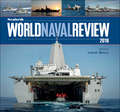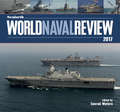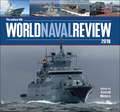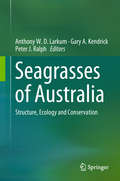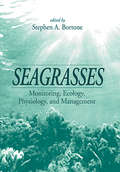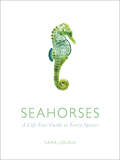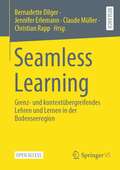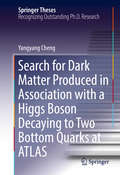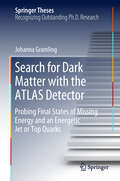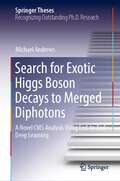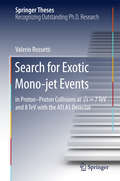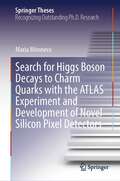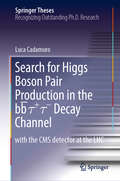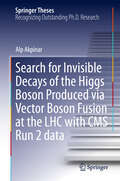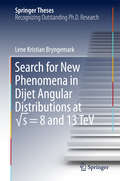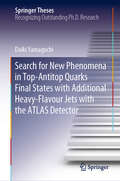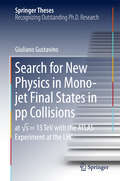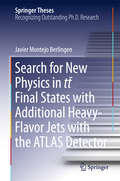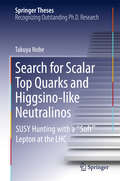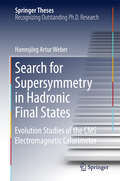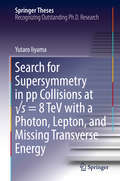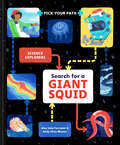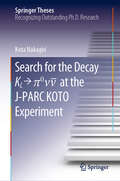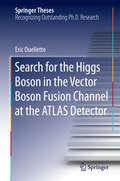- Table View
- List View
Seaforth World Naval Review 2016
by Conrad Waters&“The crème de la crème of naval writers . . . an extremely detailed overview of the last year in naval policy, construction and deployment.&”—Warship World This annual has an established reputation as an authoritative but affordable summary of all that has happened in the naval world in the previous twelve months. It combines regional surveys with one-off major articles on noteworthy new ships and other important developments. Besides the latest warship projects, it also looks at wider issues of importance to navies, such as aviation and electronics, and calls on expertise from around the globe to give a balanced picture of what is going on and to interpret its significance. This edition looks in detail at the Royal Navy as it faces the latest defense review, and evaluates the Indonesian Navy, while significant ships will include the USN&’s San Antonio class amphibious transports, the new Dutch OPVs, the Turkish Milgem class corvettes and the Greek Roussen class fast attack craft. There are also technological reviews dealing with naval aviation by David Hobbs, focusing on maritime patrol aircraft, while Norman Friedman surveys recent electronic warfare developments. Intended to make interesting reading as well as providing authoritative reference, there is a strong visual emphasis, including specially commissioned drawings and the most up-to-date photographs and artists&’ impressions. For anyone with an interest in contemporary naval affairs, whether an enthusiast or a defense professional, this annual has become required reading. &“A high-quality, deeply-researched and handsomely-illustrated book.&”—Army Rumour Service
Seaforth World Naval Review 2017
by Conrad Waters&“This fascinating book examines trends in maritime strategy and geopolitics . . . including technological advances and significant new ships.&”—Nautilus Telegraph This annual has an established reputation as an authoritative but affordable summary of all that has happened in the naval world in the previous twelve months. It combines regional surveys with one-off major articles on noteworthy new ships and other important developments. Besides the latest warship projects, it also looks at wider issues of importance to navies, such as aviation and electronics, and calls on expertise from around the globe to give a balanced picture of what is going on and to interpret its significance. Features of this edition include an in-depth analysis of the Royal Netherlands Navy, while Significant Ships will cover the USN&’s radical new Zumwalt class destroyers, the Republic of Korea&’s amphibious assault ship Dokdo, and the JMSDF&’s Akizuki class destroyers, among others. There are also technological reviews dealing with naval aviation by David Hobbs (with a focus on the present state of the RN&’s Fleet Air Arm), while Norman Friedman surveys naval surface-to-surface missiles. The World Naval Review is intended to make interesting reading as well as providing authoritative reference, so there is a strong visual emphasis, including specially commissioned drawings and the most up-to-date photographs and artists&’ impressions. For anyone with an interest in contemporary naval affairs, whether an enthusiast or a defense professional, this annual has become required reading. &“An extraordinarily useful annual from the point of view of a comprehensive update on the world&’s navies . . . a key resource for keeping up, whether in cabin or armchair.&”—Seaweed
Seaforth World Naval Review 2018: 2018
by Conrad WatersThe yearly military reference that&’s &“a well written, easy to read and well illustrated discussion of current naval power world-wide&”—Thomo&’s Hole. Now firmly established as an authoritative but affordable summary of all that has happened in the naval world in the previous twelve months, this annual combines regional surveys with one-off major articles on noteworthy new ships and other important developments. Besides the latest warship projects, it also looks at wider issues of importance to navies, such as aviation and weaponry, and calls on expertise from around the globe to give a balanced picture of what is going on and to interpret its significance. Features of this edition include an analysis of the Republic of Korea Navy and the response to its aggressive northern neighbor. Significant Ships will cover the USN&’s revamped Arleigh Burke class destroyer design, German F125 class frigates, and the RNZN&’s Otago class offshore patrol vessels. There are also technological reviews dealing with naval aviation by David Hobbs, RN missile programs by Richard Scott, while Norman Friedman turns his attention to new generation weapons technology. The World Naval Review is intended to make interesting reading as well as providing authoritative reference, so there is a strong visual emphasis, including specially commissioned drawings and the most up-to-date photographs and artists&’ impressions. For anyone with an interest in contemporary naval affairs, whether an enthusiast or a defense professional, this annual has become required reading.
Seagrasses of Australia
by Peter J. Ralph Gary A. Kendrick Anthony W. LarkumThis book takes the place of “Biology of Seagrasses: A Treatise on the Biology of Seagrasses with Special Reference to the Australian Region”, co-edited by A.W.D. Larkum, A.J. MaCComb and S.A. Shepherd and published by Elsevier in 1989. The first book has been influential, but it is now 25 years since it was published and seagrass studies have progressed and developed considerably since then. The design of the current book follows in the steps of the first book. There are chapters on taxonomy, floral biology, biogeography and regional studies. The regional studies emphasize the importance of Australia having over half of the world’s 62 species, including some ten species published for Australia since the previous book. There are a number of chapters on ecology and biogeography; fish biology and fisheries and dugong biology are prominent chapters. Physiological aspects again play an important part, including new knowledge on the role of hydrogen sulphide in sediments and on photosynthetic processes. Climate change, pollution and environmental degradation this time gain an even more important part of the book. Decline of seagrasses around Australia are also discussed in detail in several chapters. Since the first book was published two new areas have received special attention: blue carbon and genomic studies. Seagrasses are now known to be a very important player in the formation of blue carbon, i.e. carbon that has a long turnover time in soils and sediments. Alongside salt marshes and mangroves, seagrasses are now recognized as playing a very important role in the formation of blue carbon. And because Australia has such an abundance and variety of seagrasses, their role in blue carbon production and turnover is of great importance. The first whole genomes of seagrasses are now available and Australia has played an important role here. It appears that seagrasses have several different suites of genes as compared with other (land) plants and even in comparison with freshwater hydrophytes. This difference is leading to important molecular biological studies where the new knowledge will be important to the understanding and conservation of seagrass ecosystems in Australia. Thus by reason of its natural abundance of diverse seagrasses and a sophisticated seagrass research community in Australia it is possible to produce a book which will be attractive to marine biologists, coastal scientists and conservationists from many countries around the world.
Seagrasses: Monitoring, Ecology, Physiology, and Management
by Stephen A. BortoneSeagrasses are becoming widely used as in situ indicators of the relative health and condition of subtropical and tropical estuarine ecosystems. To permit meaningful management of our estuaries, there is clearly a need to develop and refine ways of effectively monitoring and assessing seagrasses.Seagrasses: Monitoring, Ecology, Physiology, and
Seahorses: A Life-Size Guide to Every Species
by Sara A. LourieAbsolutely captivating creatures, seahorses seem like a product of myth and imagination rather than of nature. They are small, elusive, and are named for their heads, which are shaped like miniature ponies with tiny snouts. They swim slowly upright by rapidly fanning their delicate dorsal fin, coil their tails to anchor themselves in a drift, and spend days in a dancing courtship. Afterward, it is the male who carries the female's eggs in his pouch and hatches the young. Seahorses are found worldwide, and they are highly sensitive to environmental destruction and disturbance, making them the flagship species for shallow-water habitat conservation. They are as ecologically important as they are beautiful. Seahorses celebrates the remarkable variety of seahorse species as well as their exquisiteness. 57 species, including seadragons and pipefish, are presented in lush, life-size photographs alongside descriptive drawings, and each entry includes detailed and up-to-date information on natural history and conservation. Sara Lourie, a foremost expert on seahorse taxonomy, presents captivating stories of species that range from less than an inch to over a foot in height, while highlighting recent discoveries and ecological concerns. Accessibly written, but comprehensive in scope, this book will be a stunning and invaluable reference on seahorse evolution, biology, habitat, and behavior. Masters of camouflage and rarely seen, seahorses continue to be a fascinating subject of active research. This visually rich and informative book is certain to become the authoritative guide to these charming and unusual wonders of the sea, beloved at aquariums the world over.
Seamless Learning: Grenz- und kontextübergreifendes Lehren und Lernen in der Bodenseeregion
by Christian Rapp Bernadette Dilger Jennifer Erlemann Claude MüllerDas Konzept des «Seamless Learning» unterstützt kontextübergreifendes und barrierefreies Lehren und Lernen durch die Integration digitaler Technologien und die Berücksichtigung von Kontext und Anforderungen der jeweiligen Lehr- / Lernszenarien. Diese Publikation beschreibt wie «Seamless Learning» konzeptionell umgesetzt werden kann und die sechs beschriebenen Projekte zeigen die Umsetzung in unterschiedlichen Wissensdomänen exemplarisch auf.Dies ist ein Open-Access-Buch.
Search for Charginos Nearly Mass-Degenerate with the Lightest Neutralino
by Shingo KazamaIn this book, the anomaly mediated supersymmetry breaking (AMSB) model is explored by searching for charged winos with their subsequent decays collected with the ATLAS detector at the Large Hadron Collider (LHC). The author develops a new method, called "re-tracking," to detect charged winos that decay before reaching the Semiconductor Tracker (SCT) detector. Because the nominal tracking algorithm at the ATLAS experiment requires at least seven successive hits in the inner tracking system, the sensitivity to charged winos having a fraction of a nanosecond in the past analysis was therefore limited. However, re-tracking requires a minimum of three pixel hits and provides a fully efficient tracking capability for charged winos traversing the pixel detector, resulting in around about 100 times greater efficiency for charged winos with a lifetime ~0. 2 ns longer than that in past searches. Signal topology is characterized by a jet with large transverse momentum (pT), large missing transverse energy, and a high-pT disappearing track. There are three types of back ground tracks: interacting hadron tracks, charged leptons, and tracks with mismeasured pT. A background estimation based on the Monte Carlo (MC) simulation suffers from large uncertainties due to poor statistics and has difficulty simulating the properties of background tracks. Therefore, a data-driven approach has been developed by the author of the book to estimate the background track-pT spectrum. No significant excess above the background expectation is observed for candidate tracks with large transverse momentum, and constraints on the AMSB model are obtained. The author shows that in the AMSB model, a charged wino mass below 270 GeV is excluded at 95 % confidence level, which also directly constrains the mass of wino dark matter.
Search for Dark Matter Produced in Association with a Higgs Boson Decaying to Two Bottom Quarks at ATLAS
by Yangyang ChengThis thesis reports on the search for dark matter in data taken with the ATLAS detector at CERN's Large Hadron Collider (LHC). The identification of dark matter and the determination of its properties are among the highest priorities in elementary particle physics and cosmology. The most likely candidate, a weakly interacting massive particle, could be produced in the high energy proton-proton collisions at the LHC. The analysis presented here is unique in looking for dark matter produced together with a Higgs boson that decays into its dominant decay mode, a pair of b quarks. If dark matter were seen in this mode, we would learn directly about the production mechanism because of the presence of the Higgs boson. This thesis develops the search technique and presents the most stringent production limit to date.
Search for Dark Matter with the ATLAS Detector: Probing Final States Of Missing Energy And An Energetic Jet Or Top Quarks (Springer Theses)
by Johanna GramlingThis book discusses searches for Dark Matter at the CERN’s LHC, the world’s most powerful accelerator. It introduces the relevant theoretical framework and includes an in-depth discussion of the Effective Field Theory approach to Dark Matter production and its validity, as well as an overview of the formalism of Simplified Dark Matter models. Despite overwhelming astrophysical evidence for Dark Matter and numerous experimental efforts to detect it, the nature of Dark Matter still remains a mystery and has become one of the hottest research topics in fundamental physics.Two searches for Dark Matter are presented, performed on data collected with the ATLAS experiment. They analyze missing-energy final states with a jet or with top quarks. The analyses are explained in detail, and the outcomes and their interpretations are discussed, also in view of the precedent analysis of theoretical approaches. Given its depth of coverage, the book represents an excellent reference guide for all physicists interested in understanding the theoretical and experimental considerations relevant to Dark Matter searches at the LHC.
Search for Exotic Higgs Boson Decays to Merged Diphotons: A Novel CMS Analysis Using End-to-End Deep Learning (Springer Theses)
by Michael AndrewsThis book describes the first application at CMS of deep learning algorithms trained directly on low-level, “raw” detector data, or so-called end-to-end physics reconstruction. Growing interest in searches for exotic new physics in the CMS collaboration at the Large Hadron Collider at CERN has highlighted the need for a new generation of particle reconstruction algorithms. For many exotic physics searches, sensitivity is constrained not by the ability to extract information from particle-level data but by inefficiencies in the reconstruction of the particle-level quantities themselves. The technique achieves a breakthrough in the reconstruction of highly merged photon pairs that are completely unresolved in the CMS detector. This newfound ability is used to perform the first direct search for exotic Higgs boson decays to a pair of hypothetical light scalar particles H→aa, each subsequently decaying to a pair of highly merged photons a→yy, an analysis once thought impossible to perform. The book concludes with an outlook on potential new exotic searches made accessible by this new reconstruction paradigm.
Search for Exotic Mono-jet Events
by Valerio RossettiThis thesis describes in detail the search for new phenomena in mono-jet final states with the ATLAS experiment at the LHC. The final state is considered the golden channel in the searches for large extra dimensions (LED) but also allows access to a very rich SUSY-related phenomenology pertaining to the production of weakly interacting massive particles (WIMPS), SUSY Dark Matter candidates, GMSB SUSY models with very light gravitino masses, as well as stop an sbottom pair production in compressed scenarios (with nearly degenerated squarks and the lightest neutralino), and also invisible Higgs searches, among others. Here, a number of these scenarios are explored. The measurements presented yield new powerful constraints on the existence of extra spatial dimensions, the pair production of WIMPs, and also provide the best limit to date on the gravitino mass.
Search for Higgs Boson Decays to Charm Quarks with the ATLAS Experiment and Development of Novel Silicon Pixel Detectors (Springer Theses)
by Maria MironovaThis book explores the Higgs boson and its interactions with fermions, as well as the detector technologies used to measure it. The Standard Model of Particle Physics has been a groundbreaking theory in our understanding of the fundamental properties of the universe, but it is incomplete, and there are significant hints which require new physics. The discovery of the Higgs boson in 2012 was a substantial confirmation of the Standard Model, but many of its decay modes remain elusive. This book presents the latest search for Higgs boson decays into c-quarks using a proton-proton collision dataset collected by the ATLAS experiment at the Large Hadron Collider (LHC). This decay mode has yet to be observed and requires advanced machine learning algorithms to identify c-quarks in the experiment. The results provide an upper limit on the rate of Higgs boson decays to c-quarks and a direct measurement of the Higgs boson coupling strength to c-quarks. The book also discusses the future of particle physics and the need for significant improvements to the detector to cope with increased radiation damage and higher data rates at the High-Luminosity LHC. It presents the characterization of the ATLAS pixel detector readout chip for the inner detector upgrade (ITk). The chip was subjected to irradiations using X-rays and protons to simulate the radiation environment at the HL-LHC. The tests showed that all readout chip components, including the digital logic and analogue front-end, are sufficiently radiation-tolerant to withstand the expected radiation dose. Finally, this book describes monolithic pixel detectors as a possible technology for future pixel detectors. This book is ideal for individuals interested in exploring particle physics, the Higgs boson, and the development of silicon pixel detectors.
Search for Higgs Boson Pair Production in the bb̅ τ+ τ- Decay Channel: with the CMS detector at the LHC (Springer Theses)
by Luca CadamuroThis thesis presents innovative contributions to the CMS experiment in the new trigger system for the restart of the LHC collisions in Run II, as well as original analysis methods and important results that led to official publications of the Collaboration.The author's novel reconstruction algorithms, deployed on the Field-Programmable Gate Arrays of the new CMS trigger architecture, have brought a gain of over a factor 2 in efficiency for the identification of tau leptons, with a very significant impact on important H boson measurements, such as its decays to tau lepton pairs and the search for H boson pair production.He also describes a novel analysis of HH → bb tautau, a high priority physics topic in a difficult channel. The original strategy, optimisation of event categories, and the control of the background have made the result one of the most sensitive concerning the self-coupling of the Higgs boson among all possible channels at the LHC.
Search for Invisible Decays of the Higgs Boson Produced via Vector Boson Fusion at the LHC with CMS Run 2 data (Springer Theses)
by Alp AkpinarThis thesis reports the latest measurements on one of the leading dark matter searches conducted by the Compact Muon Solenoid (CMS) experiment at CERN, leading to some of the most stringent constraints on hypothesized interactions between the Higgs boson and dark matter. The thesis also includes further research about the future outlook of the experiment, including exploratory research on the adaptation of deep learning models in future dark matter analyses to improve analysis sensitivity, and the design of a new type of data processing hardware to be used in the next phase of the CMS experiment.
Search for New Phenomena in Dijet Angular Distributions at √s = 8 and 13 TeV (Springer Theses)
by Lene Kristian BryngemarkThis thesis describes the use of the angular distributions of the most energetic dijets in data recorded by the ATLAS experiment, at CERN's Large Hadron Collider (LHC), the goal of which is to search for phenomena beyond what the current theory of Particle Physics (the Standard Model) can describe. It also describes the deployment of the method used in ATLAS to correct for the distortions in jet energy measurements caused by additional proton-proton interactions. The thesis provides a detailed introduction to understanding jets and dijet searches at the LHC. The experiments were carried out at two record collider centre-of-mass energies (8 and 13 TeV), probing smaller distances than ever before. Across a broad momentum transfer range, the proton constituents (quarks and gluons) display the same kinematical behaviour, and thus still appear to be point-like. Data are compared to predictions corrected for next-to-leading order quantum chromodynamics (NLO QCD) as well as electroweak effects, demonstrating excellent agreement. The results are subsequently used to set limits on parameters of suggested theoretical extensions to the Standard Model (SM), including the effective coupling and mass of a Dark Matter mediator.
Search for New Phenomena in Top-Antitop Quarks Final States with Additional Heavy-Flavour Jets with the ATLAS Detector (Springer Theses)
by Daiki YamaguchiThis book reports on the search for a new heavy particle, the Vector-Like Top quark (VLT), in the Large Hadron Collider (LHC) at CERN. The signal process is the pair production of VLT decaying into a Higgs boson and top quark (TT→Ht+X, X=Ht, Wb, Zt). The signal events result in top–antitop quarks final states with additional heavy flavour jets. The book summarises the analysis of the data collected with the ATLAS detector in 2015 and 2016. In order to better differentiate between signals and backgrounds, exclusive taggers of top quark and Higgs boson were developed and optimised for VLT signals. These efforts improved the sensitivity by roughly 30%, compared to the previous analysis. The analysis outcomes yield the strongest constraints on parameter space in various BSM theoretical models. In addition, the book addresses detector operation and the evaluation of tracking performance. These efforts are essential to properly collecting dense events and improving the accuracy of the reconstructed objects that are used for particle identification. As such, they represent a valuable contribution to data analysis in extremely dense environments.
Search for New Physics in Mono-jet Final States in pp Collisions
by Giuliano GustavinoThis thesis provides a detailed and comprehensive description of the search for New Physics at the Large Hadron Collider (LHC) in the mono-jet final state, using the first 3. 2 fb$^{{-1}}$ of data collected at the centre of mass energy of colliding protons of 13 TeV recorded in the ATLAS experiment at LHC. The results are interpreted as limits in different theoretical contexts such as compressed supersymmetric models, theories that foresee extra-spatial dimensions and in the dark matter scenario. In the latter the limits are then compared with those obtained by other ATLAS analyses and by experiments based on completely different experimental techniques, highlighting the role of the mono-jet results in the context of dark matter searches. Lastly, a set of possible analysis improvements are proposed to reduce the main uncertainties that affect the signal region and to increase the discovery potential by further exploiting the information on the final state.
Search for New Physics in tt Final States with Additional Heavy-Flavor Jets with the ATLAS Detector
by Javier Montejo BerlingenThis doctoral thesis focuses on the search for new phenomena in top-antitop quark (tt) final states with additional b-quark jets at the LHC. It uses the full Run 1 dataset collected by the ATLAS experiment in proton-proton collisions at √s=8 TeV. The final state of interest consists of an isolated lepton, a neutrino and at least six jets with at least four b-tagged jets, a challenging experimental signature owing to the large background from tt+heavy-flavor production. This final state is characteristic of ttH production, with the Higgs boson decaying into bb, a process that allows direct probing of the top-Higgs Yukawa coupling. This signature is also present in many extensions of the Standard Model that have been proposed as solutions to the hierarchy problem, such as supersymmetry or composite Higgs models, which predict the pair production of bosonic or fermionic top quark partners, or the anomalous production of four-top-quark events. All these physics processes have been searched for using an ambitious search strategy that has been developed on the basis of a combination of state-of-art theoretical predictions and a sophisticated statistical analysis to constrain in-situ the large background uncertainties. As a result, the most restrictive bounds to date on the above physics processes have been obtained.
Search for Scalar Top Quarks and Higgsino-Like Neutralinos
by Takuya NobeThis book reports a search for theoretically natural supersymmetry (SUSY) at the Large Hadron Collider (LHC). The data collected with the ATLAS detector in 2012 corresponding to 20 /fb of an integrated luminosity have been analyzed for stop pair production in proton-proton collisions at a center-of-mass energy of 8 TeV at the Large Hadron Collider (LHC) in the scenario of the higgsino-like neutralino. The author focuses on stop decaying into a bottom quark and chargino. In the scenario of the higgsino-like neutralino, the mass difference between charginos and neutralinos (Δm) is expected to be small, and observable final-state particles are likely to have low-momentum (soft). The author develops a dedicated analysis with a soft lepton as a probe of particles from chargino decay, which suppresses the large amount of backgrounds. As a result of the analysis, no significant SUSY signal is observed. The 95% confidence-level exclusion limits are set to masses of stop and neutralino assuming Δm = 20 GeV. The region with ΔM (the mass difference between stop and neutralino) 120 GeV up to 600 GeV of stop mass with neutralino mass of less than 280 GeV. The author clearly shows very few remaining parameter spaces for light stop (e. g. , topology of stop decay is extremely similar to the SM top quark) by combining his results and previous ATLAS analyses. His results provide a strong constraint to searches for new physics in the future.
Search for Supersymmetry in Hadronic Final States
by Hannsjörg Artur WeberThe project reported here was a search for new super symmetric particles in proton-proton collisions at the LHC. It has produced some of the world's best exclusion limits on such new particles. Furthermore, dedicated simulation studies and data analyses have also yielded essential input to the upgrade activities of the CMS collaboration, both for the Phase-1 pixel detector upgrade and for the R&D studies in pursuit of a Phase-2 end cap calorimeter upgrade.
Search for Supersymmetry in pp Collisions at √s = 8 TeV with a Photon, Lepton, and Missing Transverse Energy
by Yutaro IiyamaThis Ph. D. thesis is a search for physics beyond the standard model (SM) of particle physics, which successfully describes the interactions and properties of all known elementary particles. However, no particle exists in the SM that can account for the dark matter, which makes up about one quarter of the energy-mass content of the universe. Understanding the nature of dark matter is one goal of the CERN Large Hadron Collider (LHC). The extension of the SM with supersymmetry (SUSY) is considered a promising possibilities to explain dark matter. The nominated thesis describes a search for SUSY using data collected by the CMS experiment at the LHC. It utilizes a final state consisting of a photon, a lepton, and a large momentum imbalance probing a class of SUSY models that has not yet been studied extensively. The thesis stands out not only due to its content that is explained with clarity but also because the author performed more or less all aspects of the thesis analysis by himself, from data skimming to limit calculations, which is extremely rare, especially nowadays in the large LHC collaborations.
Search for a Giant Squid: Pick Your Path (Science Explorers)
by Amy Seto ForresterA new and exciting pick-your-path STEM adventure for emerging readers! <P><P> This series starter takes emerging readers on an expedition to the ocean's twilight zone in search of a giant squid. But giant squids are hard to find. Readers will need to join the expedition and help make choices along the way. <P><P> First they'll pick their submersible. And then their pilot and dive site. They'll need to be careful—not every path leads where it seems, but whatever path they pick, they';ll see and learn amazing things! <P><P> This introduction to the career of marine zoologist, and the other members of a deep-sea expedition, lets readers dip their toes into being a teuthologist—a scientist who studies cephalopods such as octopus and squid. <P><P><i>Advisory: Bookshare has learned that this book offers only partial accessibility. We have kept it in the collection because it is useful for some of our members. Benetech is actively working on projects to improve accessibility issues such as these.</i>
Search for the Decay K_L → π^0\nu\bar{\nu} at the J-PARC KOTO Experiment (Springer Theses)
by Kota NakagiriThis book reports on a new result from the KL→π0νν search at the J-PARC KOTO experiment, which sets an upper limit of 3×10-9 for the branching fraction of the decay at the 90% confidence level, improving the previous best limit by an order of magnitude. To explain the matter–antimatter asymmetry in the universe, still unknown new physics beyond the standard model (SM) that breaks CP symmetry is necessary. The rare decay of a long-lived neutral K meson, KL→π0νν, is a CP-violating decay. It is an excellent probe to search for new physics because new physics can contribute to the decay and change its branching fraction, while the SM is as small as 3×10-11. However, it is extremely difficult to search for because all of the decay products are neutral and two neutrinos are undetectable. The KL→π0νν signal is identified by measuring two photons from a π0 with a calorimeter and confirming the absence of any other detectable particles with hermetic veto counters. The book contributes to the analysis of neutron-induced backgrounds which were the dominant background sources in the search. For the background caused by two consecutive hadronic showers in the calorimeter due to a neutron, the author evaluated the background yield using a data-driven approach. For another background caused by an η meson production—η decays two photons—by a neutron that hits a veto counter near the calorimeter, the author developed an original analysis technique to reduce it. The book also contributes to the analysis of the normalization modes (KL→3π0, KL→2π0, KL→2γ) to measure KL yield, the estimation of the signal acceptance based on a simulation, and the evaluation of the trigger efficiency. As a result, significant improvements in the measurement were achieved, and this is an important step in the continuing higher sensitivity search, which can reach new physics with the energy scales up to O(100-1000 TeV).
Search for the Higgs Boson in the Vector Boson Fusion Channel at the ATLAS Detector
by Eric OuelletteThis Thesis describes the first measurement of, and constraints on, Higgs boson production in the vector boson fusion mode, where the Higgs decays to b quarks (the most common decay channel), at the LHC. The vector boson fusion mode, in which the Higgs is produced simultaneously with a pair of quark jets, provides an unparalleled opportunity to study the detailed properties of the Higgs, including the possibility of parity and CP violation, as well as its couplings and mass. It thus opens up this new field of study for precision investigation as the LHC increases in energy and intensity, leading the way to this new and exciting arena of precision Higgs research.
